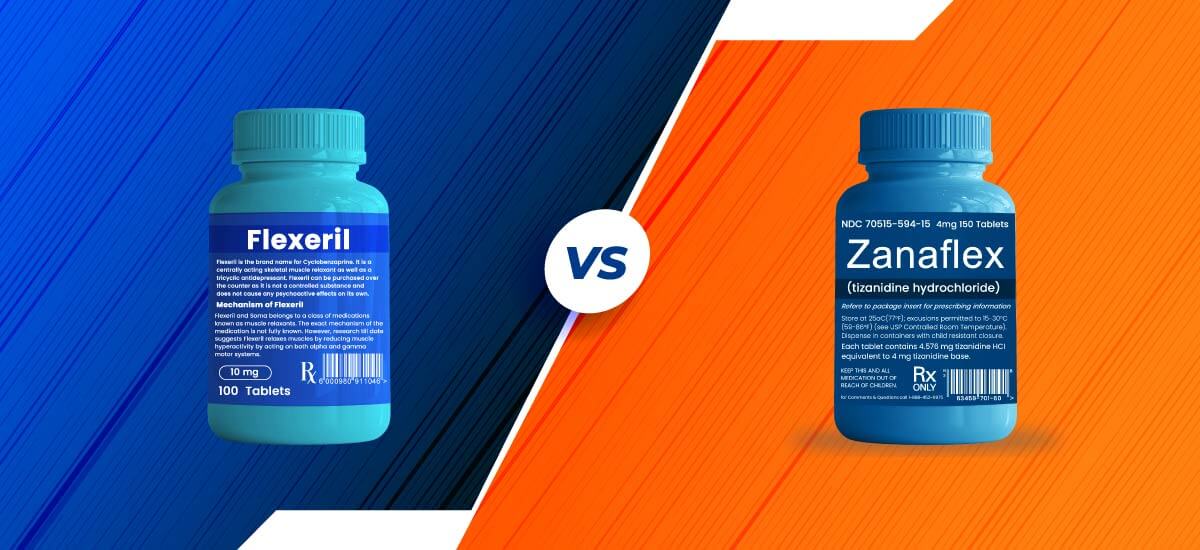Muscle relaxants such as Flexeril (cyclobenzaprine) and Zanaflex (tizanidine) are used to relieve muscle tension and cramping (spasm) caused by acute, painful musculoskeletal diseases.
Flexeril is used to treat muscle spasms as an addition to rest and physical therapy, whereas Zanaflex is used to treat disorders like multiple sclerosis or spinal damage (Dickerson, L.M., 2010).
Strength And Dosage For Zanaflex
Zanaflex is available in three strengths: 2.29 mg, 4.58 mg, and 6.87 mg.
The initial dose is recommended to be 2 mg. Because Zanaflex's efficacy peaks at around 1 to 2 hours after a dose and fades between 3 and 6 hours after a dose, treatment can be repeated as needed at 6 to 8 hour periods, up to a maximum of three doses in 24 hours.
To achieve a sufficient reduction in muscle tone, the amount can be steadily increased by 2 mg to 4 mg at each dosage, with 1 to 4 days between dosage increases. The daily intake should not be more than 36 mg.
You can buy Flexeril online from the certified online pharmacy taking a doctor’s prescription before consuming any medications (Barnes, M., 2000).
Strength And Dosage For Flexeril
Tablet for adults and children - 5mg, 7.5mg, 10mg
Capsule, extended use for adults only - 15mg, 30mg
The suggested cyclobenzaprine dose is 5 or 10 mg three times per day in immediate release pills or 15 or 30 mg once per day in extended-release tablets (Zegarra, M., 2010).
Side Effects Of Zanaflex And Flexeril
| Side Effects Of Zanaflex | Side Effects Of Flexeril |
| Dry mouth | Unpleasant taste |
| Dizziness | Nervousness |
| Drowsiness | Acid reflux |
| Back pain | Dry mouth |
| Sweating | Fatigue |
| Stomach pain | Blurred vision |
Drug Interactions For Zanaflex
- Zanaflex is mostly metabolized in the liver by the CYP1A2 enzyme. Zanaflex levels in the body can be increased by drugs that block or inhibit this enzyme.
- Increased medication levels might cause sleepiness and dizziness, among other side effects.
- CYP1A2 inhibitors like ciprofloxacin and cimetidine and birth control pills containing Ethinyl estradiol should be avoided when taking Zanaflex.
- Zanaflex may interact with drugs that depress the central nervous system. Barbiturates, opioids, and benzodiazepines are examples of these medications.
- Zanaflex might intensify their effects, causing dizziness and sedation.
Study On The Effectiveness Of Zanaflex And Flexeril
Cyclobenzaprine has been evaluated in most clinical trials with evidence to support its usage, according to a meta-analysis. Tizanidine has been shown to help with spasticity caused by multiple sclerosis. For musculoskeletal problems, such as acute neck or back pain, both cyclobenzaprine and tizanidine were proven to be helpful.
Over 100 trials comparing muscle relaxants such as Lioresal (baclofen), Soma (carisoprodol), Robaxin (methocarbamol), Skelaxin (metaxalone), and Valium were included in the meta-analysis (diazepam). Overall, the study discovered that the efficacy and safety of these medications are equal. Muscle relaxants, according to certain guidelines, produce drowsiness and should only be used for a short period.
Both Zanaflex and Flexeril are efficient muscular spasm and pain relievers. On a case-by-case basis, they are used depending on which one is most appropriate. There is currently no clinical evidence that shows a direct comparison between these two medicines (Chou R, Peterson K, Helfand M).
Also, Read
Is It Better To Take Zanaflex Or Flexeril?
Zanaflex is a relatively new medicine that has been licensed by the FDA to treat muscle spasticity caused by multiple sclerosis and spinal cord injury. Flexeril is an older medication that has been examined extensively for musculoskeletal pain and spasms. The better medicine is the one that is most effective for your condition. Consult a doctor for assistance in determining the best course of action for you (Dickerson, L.M., 2010).



 03 Jan 2022
03 Jan 2022


